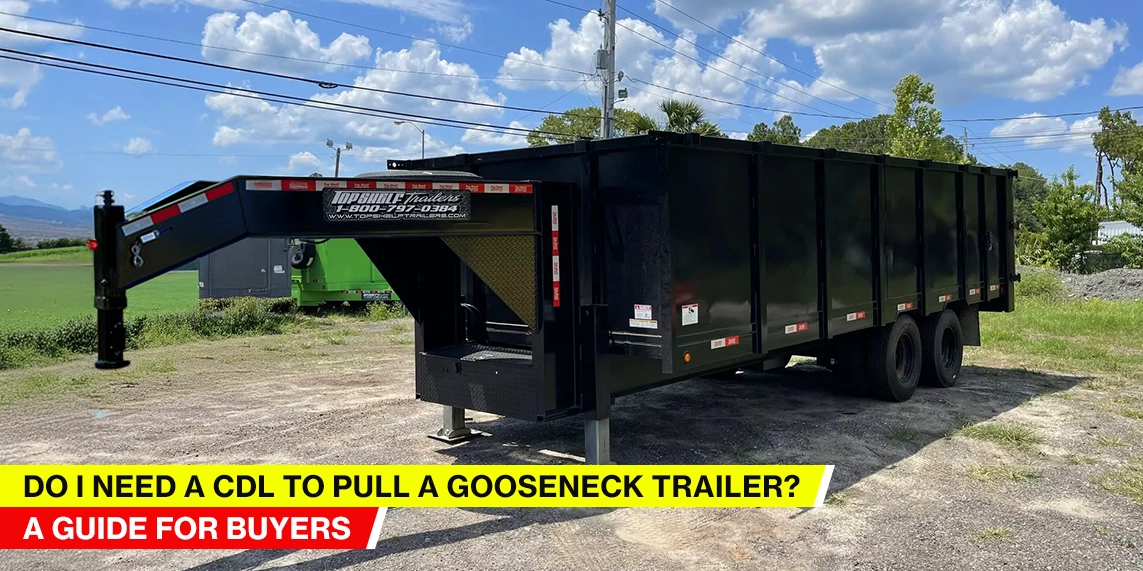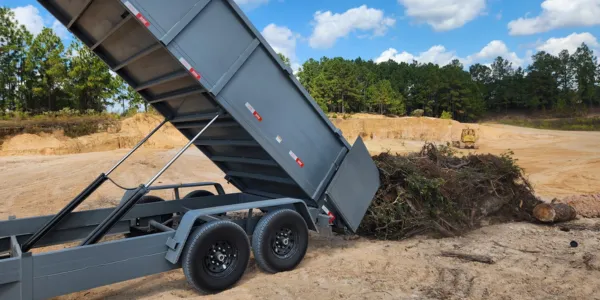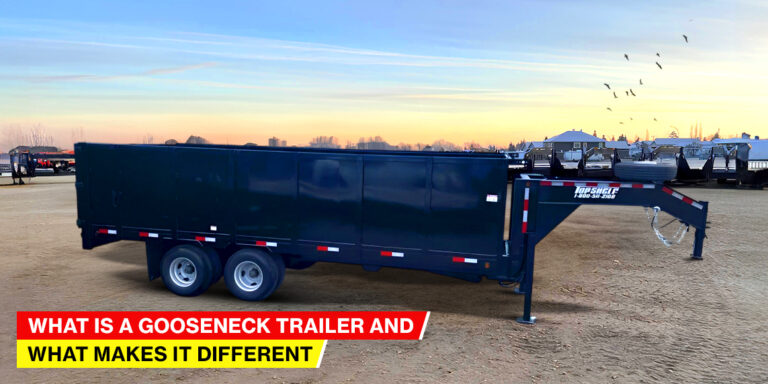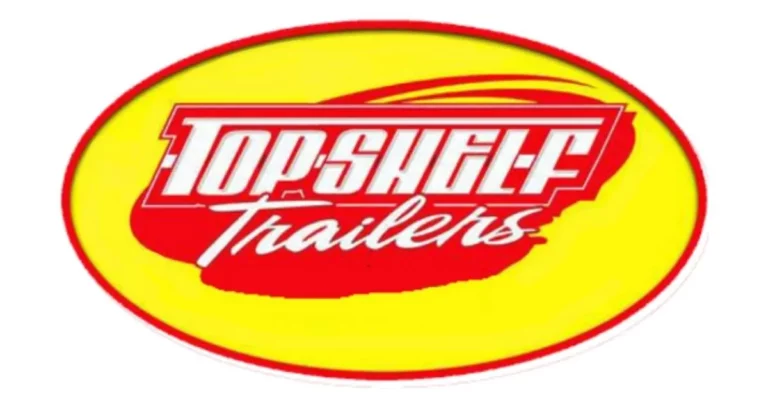Do I need a CDL to pull a gooseneck trailer? If you are troubled by this question, you have found the perfect read.
Several cases of commercial driver’s license issues have surfaced in the United States. Drivers are being pulled over with their trailers, and CDLs are being requested. According to the National Association of Trailer Manufacturers, these have become frequent. Most drivers and trailer owners are confused and looking for solutions.
Heavy-duty vehicles have unique safety concerns, regardless of the trailer type. Law enforcement and truck dealers are not entirely aware of the necessary terms. Furthermore, obtaining a CDL varies across the states.
This comprehensive read will explore whether you need a CDL to pull a gooseneck trailer, discuss the types of CDLs, and how to obtain one.
What is a CDL, and when do you need it?
Let’s learn the basics before we discuss whether you need a CDL to drive a gooseneck trailer.
CDL stands for Commercial Driver’s License for Trailer Drivers. A special license is mandatory to handle a commercial vehicle exceeding a weight threshold, which entails operating a large, heavy, and hazardous vehicle.
- A CDL authorizes an individual to operate commercial motor vehicles (CMVs).
- These vehicles are typically large trucks, buses, and others that demand specialized driving skills.
- CDLs are regulated by the Federal Motor Carrier Safety Administration (FMCSA), and individual states administer the licensing process.
When Do You Need a CDL?
The Commercial driver’s license requirements are simple. If you operate a commercial vehicle that –
- Has a gross vehicle weight rating (GVWR) of 26,001 pounds or more.
- It is designed to transport 16 or more passengers, including the driver.
- Transports hazardous materials that require placarding.
CDL Classes
CDL, or a Commercial Driver’s License, is categorized into different classes for the states in the United States –
- Class A: It allows you to operate any combination of vehicles with a gross combination weight rating of 26,001 pounds or more. However, the towed vehicle weighs more than 10,000 pounds.
- Class B: It allows you to operate a single vehicle with a GVWR of 26,001 pounds or more. It also considers a vehicle towing another vehicle weighing 10,000 pounds or less.
- Class C: It allows you to operate vehicles that transport 16 or more passengers (including the driver). A vehicle transporting hazardous materials is also considered for this category.
Key Considerations:
1. Endorsements:
CDLs can also include endorsements for specific types of vehicles or cargo, such as hazardous materials (H), passenger vehicles (P), or tank vehicles (N).
2. Regulations:
CDL regulations are designed to ensure the safety of drivers and the public.
3. Entry-Level Driver Training (ELDT):
The FMCSA has implemented ELDT regulations that set the baseline for training requirements for entry-level drivers.
Do Trailers Require a CDL?
Understanding trailers’ commercial driver’s license (CDL) requirements is crucial. It offers credibility to the towing individual’s skills. Furthermore, the license can be used for personal and professional purposes.
CDLs ensure that the heavy-load vehicle driver has the necessary skills and knowledge. However, CDLs are not generally required for all trailer towing situations.
The need for a CDL hinges primarily on the GVWR, GCWR, and usage. This includes the trailer’s Gross Vehicle Weight Rating and the vehicle and trailer’s gross combination weight rating. The specific use of the trailer, personal or commercial, is also considered.
Federal regulations set the baseline for CDL requirements. However, individual states can impose stricter rules.
The Federal Motor Carrier Safety Administration (FMCSA) mandates a CDL for vehicles –
- When the GVWR is 26,001 pounds or more.
- When the GCWR is 26,001 pounds or more, provided the towed trailer has a GVWR of more than 10,000 pounds.
A CDL is necessary if you tow a trailer that pushes the combined weight over this threshold.
Should you consider the Type of Cargo?
Beyond weight, the type of cargo plays a significant role. Transporting hazardous materials that require placards under federal regulations always necessitates a CDL. The rule is regardless of the vehicle’s weight.
Similarly, vehicles carrying 16 or more passengers, including the driver, require a CDL.
It is essential to distinguish between GVWR and actual weight. GVWR is the maximum operating weight specified by the manufacturer. The actual weight is the weight of the vehicle and its load at any given time.
Even if your actual load is below the GVWR, the GVWR is the determining factor for CDL requirements. Many states have endorsements for specific trailer types. For instance, the requirements for double or triple trailers are further complex.
So, the answer to ‘Do I need a CDL to pull a gooseneck trailer?’ is not a simple yes or no. It depends on a combination of factors. All weight ratings and cargo types are considered.
Always verify the specific regulations in the state you plan to travel to avoid legal issues.
Gooseneck Trailers and CDLs
Gooseneck trailers are known for their superior stability and weight distribution. They are frequently used for hauling heavy loads.
However, their size and capacity raise questions about CDL requirements. Understanding the CDL laws around a gooseneck trailer is essential for safety and legality.
The combined weight of the towing vehicle and trailer determines if CDL is needed. A CDL is generally required if the GCWR exceeds 26,001 pounds and the trailer’s GVWR exceeds 10,000 pounds.
This is a common scenario with gooseneck trailers. They often transport heavy equipment, machinery, and large vehicles.
Gooseneck trailers distribute weight over the rear axle of the towing vehicle. This enhances stability and handling and allows for heavier loads than bumper-pull trailers. The increased capacity contributes to the combined weight and surpasses the CDL threshold.
Commercial use of gooseneck trailers involves transporting goods for hire. It can trigger additional CDL requirements. Even if the combined weight is below the threshold, commercial use necessitates a CDL.
Examining the GVWR and GCWR of the towing vehicle and the gooseneck trailer is crucial. These ratings are found on the manufacturer’s plate or the car and trailer sticker. It is also vital to consider the actual weight of the load being carried.
Gooseneck trailers are mainly used in construction, agriculture, and heavy equipment transport, all of which often require CDL-level operation.
While not every gooseneck trailer necessitates a CDL, the typical uses demand consideration.
How Much Can You Haul Without a CDL?
The maximum weight you can haul for a non-CDL gooseneck trailer depends on federal and state regulations. The key is to stay below the federal GCWR threshold of 26,001 pounds, provided the trailer’s GVWR is 10,000 pounds or less.
Careful consideration of the towing vehicle’s GVWR and the trailer’s GVWR is essential. Furthermore, understanding the state-specific laws is necessary.
Some states have lower weight thresholds. Specific endorsements apply for trailers exceeding certain dimensions or weights, even if they fall below the federal CDL requirements.
Non-CDL gooseneck trailers are often used for smaller-scale operations. These trailers can carry loads within the non-CDL weight limits and haul personal equipment, recreational vehicles, or light construction materials.
To ensure compliance, you must verify the GVWR of your towing vehicle and trailer. This information is usually found on the manufacturer’s plate or sticker.
Personal vs. Commercial Use: Do You Need a CDL for Personal Use?
The distinction between personal and commercial use is a critical factor. It will determine CDL requirements for gooseneck trailers.
Federal regulations focus on weight and cargo type. The purpose of the haul can also influence the need for a CDL.
Personal-use gooseneck trailers are less likely to require a CDL. If you are hauling recreational vehicles, equipment, or personal project materials, you are likely to be exempt from CDL requirements, provided you stay within the weight limits.
However, even for personal use, the combined weight of the towing vehicle and trailer must comply with federal and state regulations.
It is critical to distinguish between personal and “not-for-hire” commercial use. Suppose you are you are not being paid to transport goods. Yet, if the haul is related to a business or commercial enterprise, it is commercial use and triggers CDL.
State laws further complicate the matter. Some states have specific definitions of personal use and impose additional restrictions. It is always best to verify the particular regulations in your state to avoid legal issues.
State-Specific Laws: Towing Laws by State
Federal regulations provide a baseline for CDL requirements. State-specific laws significantly impact the rules for gooseneck trailers.
They vary widely, affecting weight limits, trailer dimensions, braking requirements, and endorsements.
Some states have adopted the federal CDL regulations, and others include additional restrictions. For instance, some states have lower weight thresholds for CDL requirements, making CDL a must for vehicles and trailers with lower combined weights.
Each state has the authority to implement its rules and regulations, some of which often exceed the federal minimums. The variability necessitates meticulous research and adherence when planning a trip.
Let us explore –
1. California
California, known for its stringent vehicle regulations, has specific rules for trailer towing. The California Vehicle Code mandates a Class A non-commercial license for towing a trailer. This applies to a GVWR of over 10,000 pounds, even for personal use. The law is similar if the combined GVWR exceeds 26,001 pounds.
You might need a specialized license even if you are not engaged in commercial activities. Furthermore, California has strict regulations on trailer dimensions. These entail maximum width and length and braking systems exceeding certain weights.
Notably, California also has rules about safe towing speed. It differs from regular speed limits when towing.
2. Texas
Texas has vast highways and significant agricultural and industrial sectors. Each sector uses trailers for varied activities, so a comprehensive set of towing laws exists.
The state generally aligns with federal CDL requirements. However, they also have specific regulations for non-commercial towing.
Trailers with a GVWR exceeding 4,500 pounds must have independent braking systems. Specified trailer lengths, widths, appropriate safety chains, and lighting rules exist.
Texas also has specific rules for towing farm equipment and recreational vehicles.
3. Florida
Florida’s towing laws are tailored to its diverse transportation needs. It encompasses commercial and recreational towing.
Along with the federal rules, Florida CDL Requirements have additional terms and conditions. For instance, trailers exceeding 80 inches in width or 35 feet in length have specific lighting and reflector rules.
The state regulates the use of mirrors and safety chains. All trailers of a certain weight must be equipped with brakes. Additional laws for towing boats are worth considering.
4. Pennsylvania
Pennsylvania’s towing laws include specific provisions for trailer braking systems and lighting. The state requires independent braking systems for trailers with a GVWR of 3,000 pounds or more.
They also have detailed regulations regarding trailer dimensions and weight distribution. Specific rules apply if mobile homes are being transported with a gooseneck hitch.
5. New York
New York has dense urban and extensive rural regions and stringent towing laws. The law follows federal requirements, and there are additional restrictions.
Similar to other states, trailers exceeding 3,000 pounds GVWR must have independent brakes. Safety regulations are enforced, including the use of safety chains and lighting.
Other states like Arizona, Washington, Illinois, and Michigan have the same regulations as New York. Trailers exceeding 3,000 pounds GVWR must have independent braking systems. Rules regarding weight distribution and safety measures also exist.
These are only a few of the examples. Each state has a unique set of towing laws. Drivers must consult before traveling through to ensure compliance and avoid penalties. State Department of Motor Vehicles websites and state agency publications are valuable resources. They have the detailed and up-to-date information.
Frequently Asked Questions (FAQs)
We have covered all the essential queries regarding CDLs, towing, and gooseneck trailer weight limits. Let us revamp –
1. At what weight do you need a CDL?
You will need a CDL in the United States if you operate a single or combined vehicle of 26000 pounds or more. CDLs are of varied classes. We have thoroughly explained them in this article; kindly refer.
2. Can I operate a Gooseneck Trailer without CDL?
A gooseneck trailer typically weighs 7000 to 10000 pounds and has a towing capacity of 16000 pounds. Together, it exceeds a CDL requirement, and you must possess one.
Furthermore, a CDL is necessary if you use the gooseneck trailer commercially.
3. Are non-CDL gooseneck trailers a possibility?
Whether you need a CDL for your gooseneck trailer depends on its weight and intended use. State laws vary, and we advise consulting with the trailer manufacturers for appropriate information.
4. How much can you haul without a CDL?
You can seamlessly haul a vehicle without a CDL if the total GVWR exceeds 26000. This is the maximum weight limit for non-CDL trailers and includes the towing vehicle and the trailer.
5. Do you need a CDL for personal use?
Trailer weight restrictions apply to both commercial and personal-use vehicles. However, weight and intended purpose play crucial roles. For instance, suppose you are using your trailer to shift a haul for a business. Even if you are not getting paid, the intended purpose is commercial, and you must possess a CDL.
6. What is the GVWR of a trailer?
GVWR, the Gross Vehicle Weight Rating, is the maximum weight the trailer can safely handle, including the cargo. The GVWR ensures safe driving, structural integrity, and legal compliance across the states.
Before You Shop for Gooseneck Trailers in the United States
As discussed, understanding when you need CDL is essential. It ensures you invest correctly and do not fall prey to legal issues.
The rules and regulations vary slightly between states. However, we suggest consulting our experts if you plan to invest in a gooseneck trailer.
You can find the best trailers at Top Shelf Trailer for your towing needs. We have the most exclusive collection of gooseneck trailers.
Furthermore, our trailer experts are adept in CDL laws and regulations and will offer you full-scale guidance.
To learn more, consult the best dump trailer manufacturers in the United States – Top Shelf Trailers.





